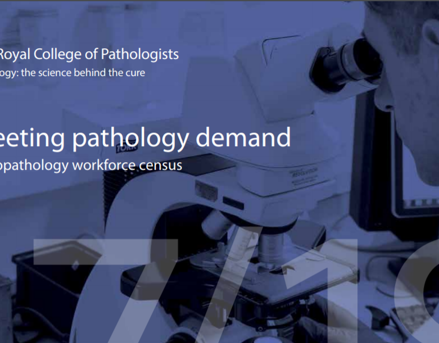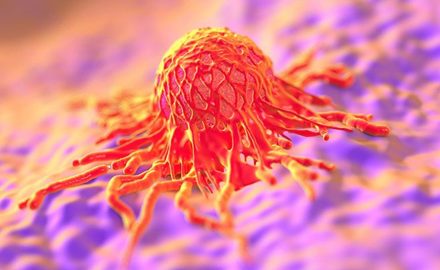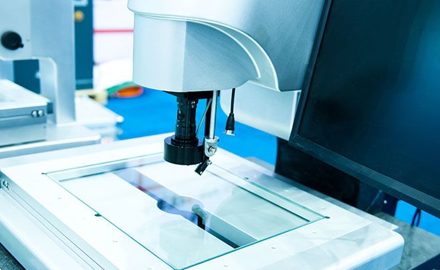The pathology workforce
What is the role of pathologists? Working in hospitals and the community, pathologists and pathology staff are involved in preventing, diagnosing, treating and monitoring diseases to keep people as healthy as possible.
Pathologists are facing great pressures through the rising workload, the increasing complexity of their work and vacancies of 10–12% and rising. The amount of histopathology requests to laboratories has increased by around 4.5% on average year on year since 2007.
Pathology workforce challenges
There is a growing demand for pathology services, both in the number and complexity of tests performed, caused by developments in testing such as the introduction of the faecal immunochemical test (FIT), which will increase clinical biochemistry and histopathology workload, and new targeted therapies needing genetic or molecular tests on samples.
Cancer Research UK's report, Estimating the cost of growing the NHS cancer workforce in England by 2029 indicates that a 45% staff increase is needed across 7 cancer-related professions to meet Health Education England’s (HEE) aim to provide world-class services for cancer patients by 2029.
However, for the histopathology workforce, the report findings show that without targeted action and investment, the number of histopathologists is forecast to reduce from the existing shortfall by an additional 2% by 2029.
- In 2017, for example, our training post fill rates in England dropped to 72% in histopathology from almost 100% in the previous 2 years.
- For those who do go into specialist training, pathology is competing with other disciplines for trainees.
- However, for the first time in recent years, we are not having to go out to second-round recruitment for specialty trainee (ST1) training in histopathology in most regions in the UK.
Our workforce census, Meeting Pathology Demand found that just 3% of histopathology departments have enough staff to meet clinical needs.
Clinical biochemists play a key role in diagnosing patients with a wide variety of illnesses – from high cholesterol to rare genetic diseases. Haematologists (pathologists who help diagnose and treat blood cancers and other blood disorders) are also in short supply. Staffing levels have not risen in line with demand and there are not enough trainee doctors in post to fill the gaps in the workforce. The College haematology briefing – Feb 2020 found that haematologists are finding it increasingly difficult to undertake vital diagnostic work in the laboratory.
Building the cancer workforce, not just in histopathology, but also in haematology and other areas of pathology, has to be a key investment priority for the government. Without this investment, there will be no capacity for pathology to deal with any increase in workload associated with efforts to overcome this backlog.
As well as more investment to recruit and retain more pathology staff, we also would like to see more training places, better IT for day-to-day work and capital investment to implement digital pathology more widely, so staff can work more efficiently and flexibly. Digital pathology (whole slide imaging) is a technology that allows glass histopathology slides to be reviewed digitally on a computer screen, rather than with a microscope. As a result, it is a technology that can transform pathology services in the NHS and beyond. The technology is relatively new and rolled out in a relative minority of labs and but increasing numbers are now using it for substantial amounts of diagnostic work.
We are very concerned that, without investment in pathology, it will not be possible to tackle the burgeoning NHS waiting list. The pathology workforce is key to reducing this, especially in cancer diagnosis. The pathology workforce is also crucial to disease prevention, infection control and good antibiotic stewardship. Our workforce is facing chronic shortages, and it is vital that investment is targeted at pathology services to alleviate these pressures and meet increased demand.
Digital pathology also facilitates remote working in several ways which will help with staffing issues - home reporting, avoiding the need to be physically in the same space as a colleague giving a second opinion, and facilitating trainee pathologists in learning.
Any investment should also build on the initial investment of the NHS to develop centres of excellence in digital pathology nationally. These centres can help with any further expansion of the technology across the NHS, by sharing knowledge and standards. It is the view of the College that digital pathology should be centrally funded and rolled out nationally in a similar way to digital radiology.
Our work in this area
Comment on consolidation
Over the past decade or so there has been a move toward consolidation of pathology services. The need to develop and rationalise services is driven by a variety of forces that depend on local circumstances and healthcare needs, but which often include workforce and financial pressures. As a result, consolidation of services takes on a variety of forms with some more successful than others.
Read our College commentary on the consolidation of pathology services:
RCPath Commentary - Consolidation of pathology services
The College Workforce team conducted a formal survey of all UK histopathology/cellular pathology departments in 2017. This was the first such comprehensive survey to be sent out to the managers of all the pathology departments in the UK. The results showed that almost 1 in 6 posts are either covered by locums or are vacant. From the data supplied in the survey, the cost of outsourcing work and the use of locums is estimated at approximately £27 million. Only 3% of NHS histopathology departments reported that they have enough staff to meet clinical demand. Better and more coordinated workforce planning is needed over the next 5 years as the number of retirements from the NHS is expected to increase significantly.
The College has successfully argued for a lift in the Tier 2 visa cap for doctors and nurses and we are glad to see this. Whilst the College supports the move in the draft health and care workforce strategy to 2027 ‘Facing the Facts, Shaping the Future’ to maximise home-grown trainees, so that we have sufficient pathologists from UK medical schools, ongoing immigration will be necessary to assist with the workforce shortages in pathology.
There are some additional things that will help. The College supports the adoption of technologies that have the potential to improve patient care, introduce efficiencies and support the pathology workforce, such as digital pathology.
Also on the agenda



